#paleo reconstructions
Explore tagged Tumblr posts
Text
Theropod Facial structure theory
I have been trying to write this paper out so many times and the lack of funds to hire an editor/publish as well as getting this organized in a fashion that's considered proper for a scientific paper has caused me to hit so many walls, not including the learning disabilities that have made this worse to get this out. So i'm doing this to get what information i've been gathering since 2018.
looking at young corvid images of their open mouth, they had a lip area in their mouth that the upper beak would overlap and lay in perfectly, this is what started me down the road along with noticing the formina on the sides of theropod faces matched that of goose skulls I saw online. As I had no access to actual specimens in person.
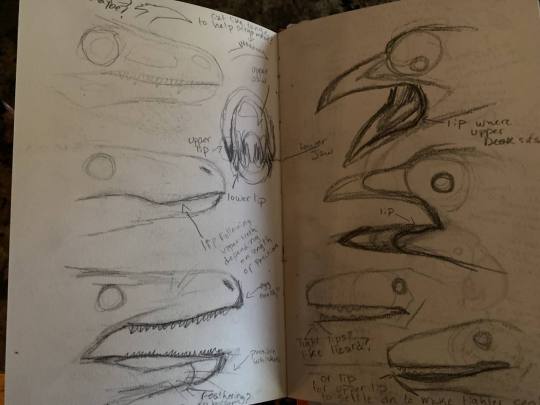
feeling as though waterfowl specimens were the easiest to obtain(they were actually more difficult than thought) as well as being closer to dinosaurs on the evolutionary tree next to ratites, and even living along dinosaurs during the late cretaceous ie presbyornis, they seemed to be the best to study for this.
After obtaining a pair of peking duck and an african goose, from some local farmers that donated them, they were dissected and preserved using techniques learned from taxidermy for study. The specimens had one side of their bills removed while leaving the skin intact on the otherside. One of the peking ducks kept the tissue on both sides, while only one side had the top layer of the epidermis removed, exposing the harder dermis underneath. A noticeable attribute was that before preservation the bills were plump and didn't show any texturing, except for the goose around the back nearest to the corner of the mouth. Once preserved however, the skin on the bills shrank, revealing grooves and texturing where nerves and blood vessels would run.
The sensory organs and nerves that ran in the bills were observed using a candlelight method/ie holding them up to the light.

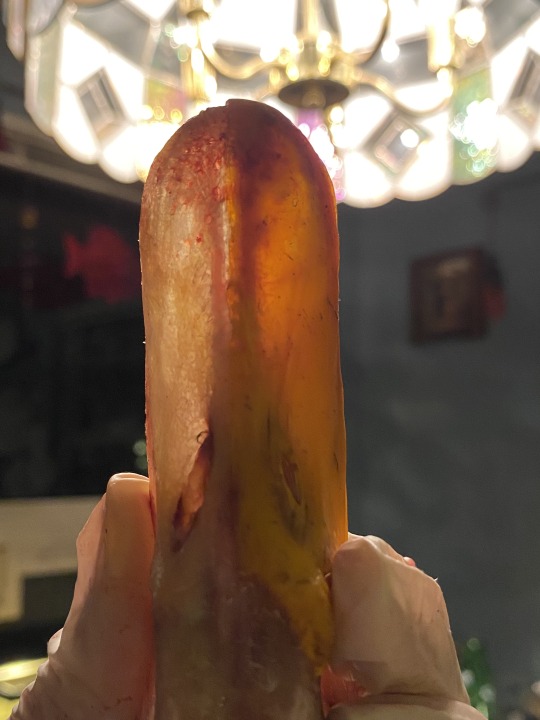

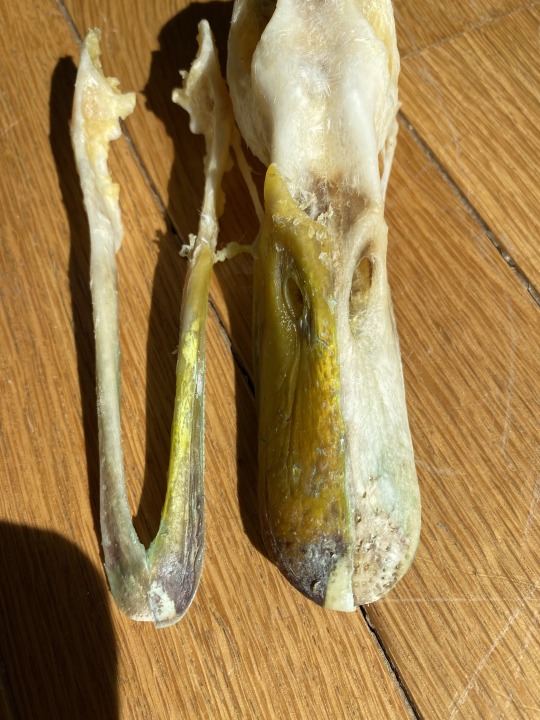

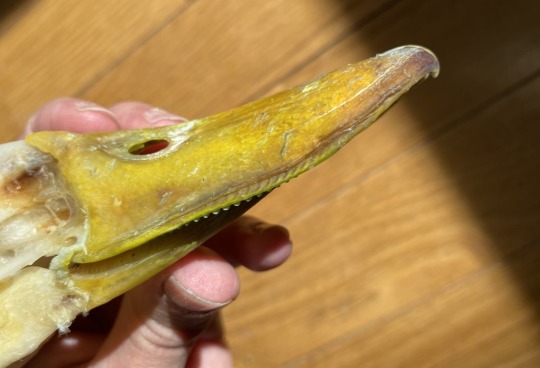
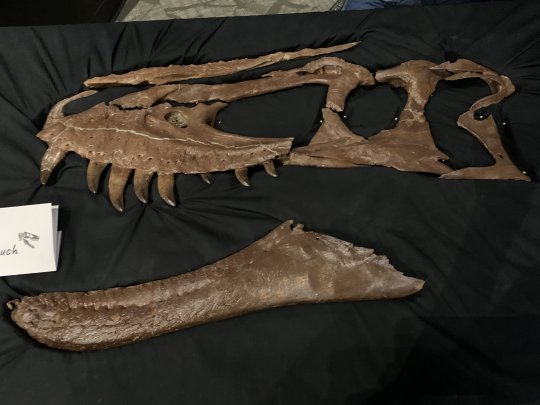
Tyrannosaurus Juvenile Jane specimen for comparison
The deep grooves and formina on the bill, as well as the formina and grooves that are seen in T.Rex have many similarities, which was the main focus of this study as they're are numerous studies pertaining to their sensory organs. Also something to compare is that there is a distinct row of formina that's more prominent on older crocodiles and alligators along the dentiary similar to that of T.Rex, on both the top and bottom row of the mandibles.

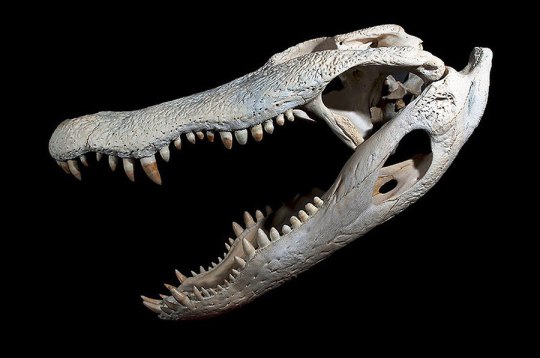
saltwater crocodile head from crocodiledarwin.com and alligator from encyclopediaofarkansas.net

komodo dragon profile view(comparing formina)
Though waterfowl having lamillae cannot be used to compare enamel ware. While crocodiles and alligators have teeth, but are known for not having lips, have ware and tare on their teeth than animals like monitor lizards that have lips as shown in this study using a relative of Tyrannosaurus rex to prove they had some form of lip to protect their tooth enamel.
Another observation is that in alligators the bottom row of dentary is tucked under the upper mandible and covered more than in crocodilians. It would be interesting to see the tooth study done with other teeth on both animals, as some of the posterior dentary on the upper mandible can sometimes be seen tucking away in a pocket of skin as protection in some alligators.
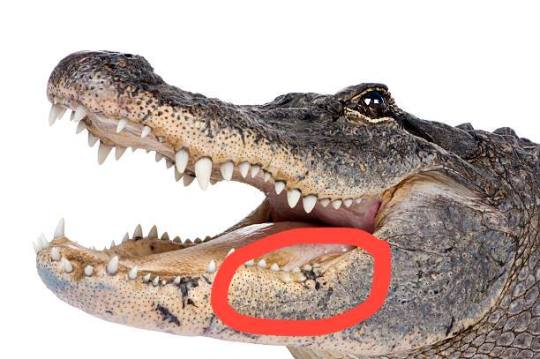
Also looking at neonatal alligators shows a depression in the lower jaw area that the upper dentary could sit in, almost as though their reminants of lips

neonatal alligator from natgeo on alligator facial mechanoreceptors
and while alligators and crocodilians seem to have scaling on their face this is just thickened sensitive skin with cracked texturing imitating scales. Bills on waterfowl are also thickened as this allows them to forage in merky waters and plants without damaging their bills. While both animals have thickened skin on their manidbles, it is still a very sensitive part of their body that they use to navigate and explore/manipulate their environment as well as interact with other of their species. While reptiles have less sensitivity and do not share these organs along their faces(the skin sense organ of some iguanian lizards). This could be also a lack of information on the anatomy of reptile skulls and facial structures that could be expanded more for comparison.
However there was a study done on the facial sensitivity of Tyrannosaurus along with alligators
See Complex Neurovascular system in the dentary of Tyrannosaurus
See Despite their thick skins, alligators and crocodiles are surprisingly touchy
and while it took awhile to find and make available, there had been a paper written on a very similar organ within the bills of waterfowl, namely mallard ducks.
See The Morphology and Distribution of Cutaneous Mechanoreceptors(Herbst and Grandry Corpuscles in Bill and Tongue of the Mallard)
And while Monitor lizards and other reptiles share a similar formina pattern, they lack the textured grooves and sensitive organs archosaurs and certain avians share, as well as other anatomical features of moniotor lizard skulls that they share more closely with other reptiles and snakes than they do with the archosaurians and avians.

komodo dragon skull ventral view
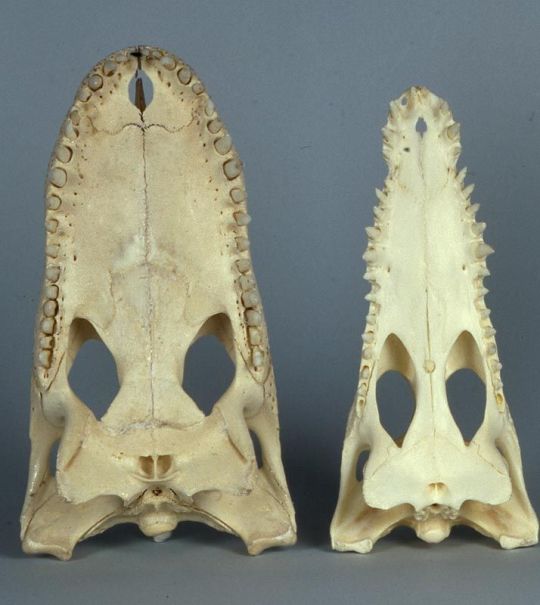
Alligator(left) Crocodile(right) ventral views of skulls

Peking Duck skull with bill skin(ventral view)

T.Rex skull ventral view
another observation in many reptile skulls is how the upper and lower dentary interact. While some had teeth that overlapped the lower mandible, there seemed to be somewhere that the teeth met, either at the anterior end of the skull or continually all around, in monitors there was some sort of gap at the anterior portion of the dentary to make way for the tongue to be able to slide in and out without being obstructed too much while allowing the mouth to stay closed. Where as archosaurs and avians the two overlapped one another allowing for a scissoring affect with the teeth, the most noticeable being the anterior end of the mandibles. And while waterfowl lack the dentary that archosaurs and reptiles have, the lamillae still slide past one another similar to what's observed in many theropods, even in non avian dinosaurs. The thought of bone to tooth contact is considered as well, and there can be a sizeable closure without the need for the amount of soft tissue observed in reptiles.
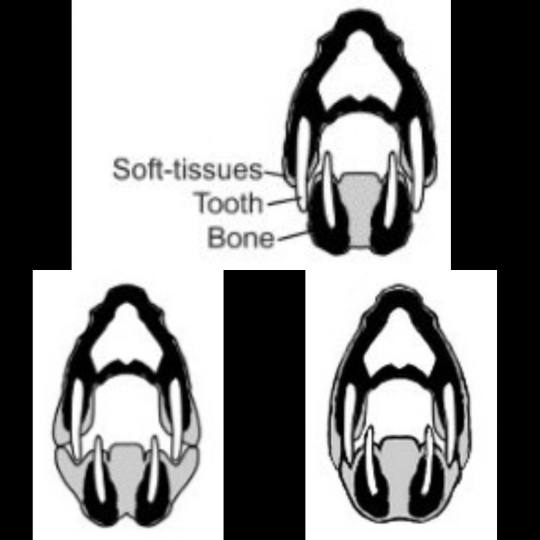
proposed crocodilian like contact of tooth on mandible(top), proposed soft tissue similar to that of monitor lizards(bottom left), new proposed soft tissue without scaled lips(bottom right)
Having soft tissued lips that is similar to that of a waterfowls bill allows for the mechanosensory corpusicules to interact as well as still allows for protection of the tooth enamel.
The way their upper dentary line up with their lower mandibular formina seems to follow the same pattern, compared to reptiles that didn't curve upwards towards the anterior portion of the lower mandible. There's also a possibility of having a nail, like waterfowl, or some large scale, like many other reptiles with dentary, at the anterior ends of the upper and lower manible. This is due to the amount of formina clustering in a pattern like structure similarly seen in both waterfowl and reptiles.
These observations and studies allowed for an idea of how to reconstruct Tyrannosaurus Rex




Juvenile Jane Tyannosaurus Rex skull, with open and closed mouth(top) and reconstructions
Even constructing a physical reconstruction to better observe how the lips and teeth would interact.
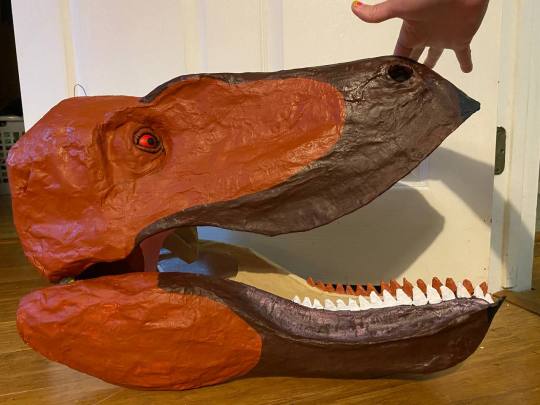
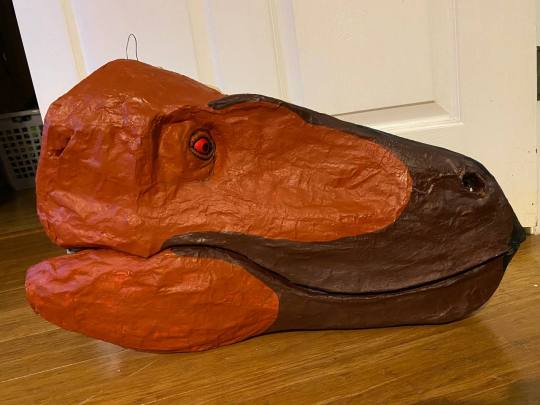


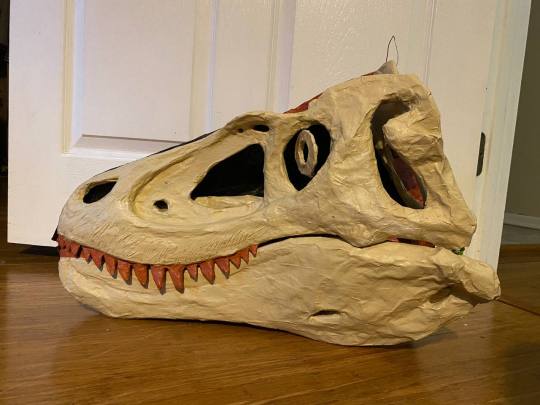
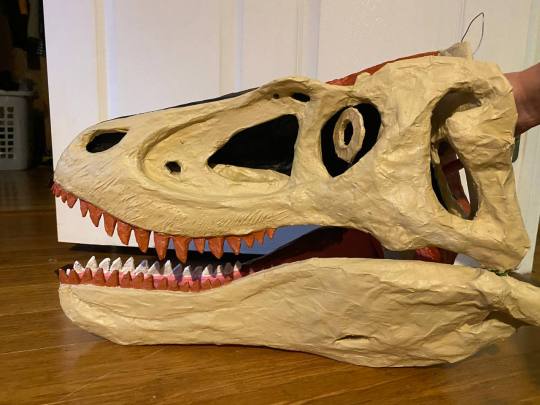
Paper mache head reconsturction done in a similar manner to the duck and goose specimens used in this study
Also when reconstructing, and also accounting for tooth slippage, there was an issue with a sizable gap at the anterior end with the front dentary when closing the jaws when attempting to imitate the mouth closing similar to that of previous reconstructions using reptile lips, where as with the more waterfowl skin reconstruction there was less of an issue and also less of an overhanging bottom lip.
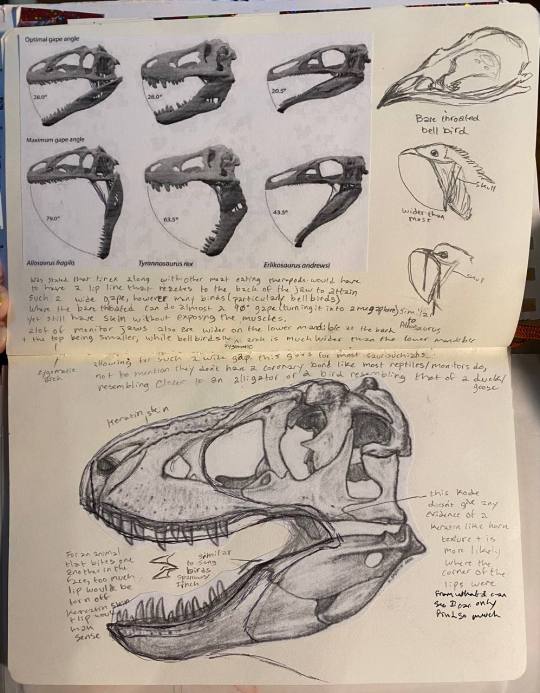
Pages from personal study notes
There was also the issue of either exposing the jaw muscles similar to how crocodilians, alligators, and other reptiles are observed to have, or to cover it in skin like birds. One of the arguments is that the mouth wouldn't be able to open to the extent allosaurians and tyrannosaurus are able to open their mouths. When there are several avian species with skin over the area that can very well open their mouths just as wide, ie Bell Birds, which have a widened jugal bone like that of tyrannosaurus.

Young tyrannosaurus specimen(chomper)
Also to note, in most reconstructions where there is a bony knob on the jugal, circled in the above example, is more than likely a muscle attachment point, and the divet in the space before the attachment point could allow for the corner of the lips to sit.
In conclusion, Tyrannosaurus Rex and possible other theropod dinosaurs with similar skull anatomy of the upper and lower mandibles more than likely had thickened yet sensitive skin with a lip like structure similar to that of waterfowl and not a scaled skin.
Additional research papers on duck bill anatomy/mechanreceptors
Histomorphogenesis of Upper Beak in Muscovy Ducks (Cairina moschata)
3D architecture and a bicellular mechanism of touch detection in mechanosensory corpuscle
Molecular basis of tactile specialization in the duck bill
Personal Notes on research
#paleoart#paleontology#research#study#scientific study#dinosaur#theropod#art#reconstructions#paleo reconstructions#tyranosaurus rex#trex#tyrannosaurus#duck anatomy#science papers
294 notes
·
View notes
Text

Ceratosaurus and allosaurus heads, as a little experiment... Sizes aren't up to scale, just wanted to color and edit a sketch of mine digitally.
#paleo#prehistory#dinosaurs#dinosaur art#dinosaur illustration#dinosaur reconstruction#theropoda#theropod#paleobr#paleoart#paleomedia#ceratosaurus#allosaurus#jurassic period#morrison formation#lourinha formation
64 notes
·
View notes
Text
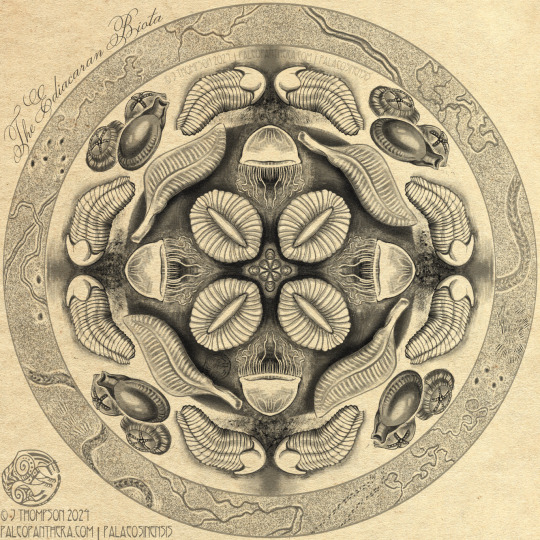
Alright science art and paleo art folks go gentle on me. If I was to do these for a gallery showing I think I'd need at least a couple of weeks for research and notes alone. More if I reached out to researchers for paper access and feedback. Speculative armored invertebrates, Dickinsonia, speculative medusa, Charnia, Spriggina, Kimberella, Arkarua, & their trace fossils.
#ancient life#fossil#fossils#ediacaran#science art#paleo art#dickinsonia#charnia#spriggina#kimberella#arkarua#trace fossils#art#drawing#digital art#illustration#palaeosinensis#paleo panthera#paleopanthera#mandala#pencil#digital pencil#reconstruction#paleoart#paleontology#prehistoric#prehistoric animals#animals#ancient
74 notes
·
View notes
Text

cryolophosaurus ellioti, a large theropod from early jurassic antarctica
commission info
#i started this like 5 months ago lmao#fuckin adhd#cryolophosaurus#cryolophosaurus ellioti#neotheropod#dinosaur#dinosaurs#theropod#theropod dinosaur#theropoda#paleontology#jurassic#jurassic period#prehistoric animals#early jurassic#paleoblr#paleoart#paleo illustration#dinosaur art#dino art#my art#dinosaur reconstruction#added protofeathers bc i hate myself
69 notes
·
View notes
Text

protosuchus sniff you now
386 notes
·
View notes
Text
A school of saxofones
A school of Macroscaphites search for the best plankton-rich current for suspension feeding
665 notes
·
View notes
Text

Deep in the ancient oceans, lurks the mighty Dunkleosteus. A bit of Blockbench paleo art from a little while back i never posted.


Based on the recent, more rotund, reconstruction of D. terrelli, still quite the fearsome beast!
Been some time since i did any paleoart so it was great to finally get back to it again!
Let me know what you think!
#my art#artists on tumblr#3dartist#blockbench#paleo art#paleoart#paleoblr#paleontology#prehistoric animals#dunkleosteus#D. terrelli#dunkleosteus terrelli#devonian#fish#mineblr#minecraft#placoderm#palaeontology
7K notes
·
View notes
Text
to start the year nicely: i'm currently available for some work on scientific illustrations and paleo reconstructions! I work with both extant and extinct animals, so it's pretty much anything you want (yes, including OCs, if they're not too fantasy-like; hovewer, i will prioritize science-based work). Here are some of my recent works to see!








The prices for simple reconstructions (simple background, no scenery; like Eohippus pair or three Psittacosaurus above) start somewhere at 300-400 EUR, but everything depends on the work and level of render, we can always discuss it🌱 You can contact me here or on Bsky! And please, be aware or scamm*rs - I won't contact you first and I won't ask for money if you didn't contact me in the first place! I only take payment through Boosty rn. Thank you! ☁
994 notes
·
View notes
Text
Yesterday our paleo crew got together to get some of our best specimens CT scanned at CHI St. Alexius Hospital in Dickinson. The scans are already revealing things about the internal processes of dinosaur skulls that wouldn't normally be visible. Much more will be elucidated upon further study.
We aim to reconstruct our Lambeosaurus' resonating chamber to hear its honk, show off the D. wilsoni holotype's replacement teeth and abscess, and see just how small ceratopsians' brains really were.
#paleontology#palaeontology#science#paleo#palaeo#badlands dinosaur museum#dinosaurs#fossils#museums#natural history#Lambeosaurus#liberty#Daspletosaurus#sisyphus#museum#not prep
85 notes
·
View notes
Note
*presses my face against the askbox*
You reblogged dinosaur post. Is this ... perchance foreshadowing of dinosaur drawing????????????????????????????????????????????
No pressure if no but I now cant stop thinking of dinosaurs in the way you might potentially draw them
💕💕💕💕💕💕
I do enjoy me a dinosaur!! I reblogged that because my friend Hazard made it and I was the one who supplied the duck specimens for it, and it's super interesting and I think paleo art and reconstructions are sick! I have thought of doing dinosaurs before, though, so all we're waiting for is the mood to strike. Hee hee. Spoilers: my favorite dino is parasaurolophus.
Here's a piece I did in 2020 of a dilophosaurus for my friend's tattoo shop, Jurassic Ink in Federal Way, WA.

(As you can see it's not terribly scientific, har har. The hardcore scientific illustration/paleoart community doesn't seem like my jam. Respect to them, just not for me.)
34 notes
·
View notes
Text










The Milan Cathedral is located in Milan, Italy. Construction of the Catholic church began in 1386 by Archbishop Antonio da Saluzzo and Lord of Milan, Gian Galeazzo Visconti, but it didn’t end until 1965. The cathedral was built upon an earlier basilica. Due to the centuries of construction and reconstruction, the cathedral plans took form with major decisions to expand or tweak things made by a team of workers. Even Leonardo da Vinci tried to accomplish the hard task of designing the tiburium (the lantern tower). It has stood guard over Milan for more than 600 years. In 1389, the chief architect Nicolas de Bonaventure wanted the cathedral to be done in the Gothic style; this included the pink marble covering the cathedral exterior, including white spires and pinnacles, 135 gargoyles, and towers holding statues. The cathedral was consecrated by Pope Martine V in 1418, but only the nave was finished. The Duomo remained unfinished for centuries due to a lack of funding. Work on the church’s façade design began at the end of the 16thcentury, but the plan wasn’t completed until the end of the 18th century. Giuseppe Perego sculpted the copper Madonna statue located at the temple’s highest point in 1774, which serves as a symbol of Milan. New work began on the façade in the early 19th century, with most of the spires added to the roof and many stained-glass windows finished. In the 20th century, conservation work was completed, but various phases of restoration continue today. The cathedral has 135 spires, 250 stairs, and 3,400 statues. Inside there are five naves, a transept, forty pillars, an apse, and a choir. The building has the capacity for more than 40,000 people. The cathedral portrays stories of the Bible depicted on stained-glass windows, along with beautiful mosaics and paintings. There’s also a marble staircase, carved floor-to-ceiling statues, a 9th century crypt, beautiful terraces, and the Cathedral Treasure, which houses paleo-Christian and Romanesque objects. The Milan Cathedral is one of the largest Christian churches in the world and the biggest gothic cathedral ever built. It stands 45 meters high and is 157 meters in length.
10 notes
·
View notes
Text
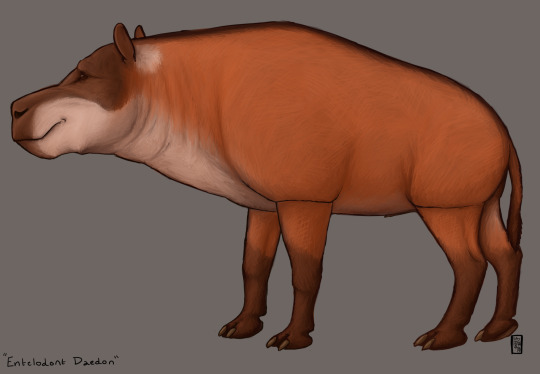
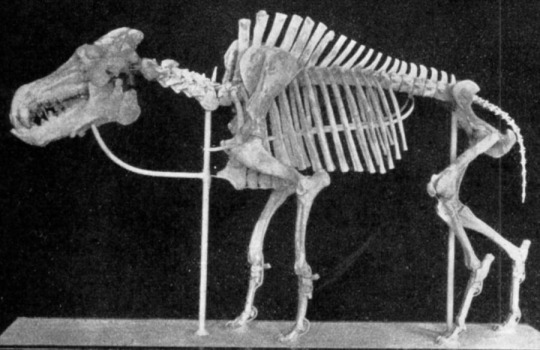
“Entelodont Daedon”
Updated my rough sketch on this guy and worked on the body and feet more, I feel satisfied with how they look now, gonna keep the red cause it’s a color and markings that have grown on me since working on reconstructing this weirdo.
I hope you enjoy their new slippers, looking at ungulate foot bones to compare anatomy and concluded they resemble closer to a camelid/pygmy hippo than to a bovid or other hooded ungulates.
Still working on the nose, but I think I might have it down finally. Been comparing a lot of nasal bones and their structures to get a better build on this guy.
#entelodont#daedon#entelodont daedon#hippo from hell#hell hippo#hell pig#paleoart#paleo reconstruction#paleontology#paleo mammal#mammalian#digital art#art#animal art#ungulate
67 notes
·
View notes
Text

If everyone in the internet was an allosaurus, he'd get told to "cover it up!!" for posting a selfie like this. u_u
#paleo#prehistory#paleoart#palaeoart#dinosaur reconstruction#dinosaur art#theropod#theropoda#dinosaurs#palaeoblr#paleontology#allosaurus#allosaurus oc#jurassic period#dinosaur oc#dinosaur character
90 notes
·
View notes
Text
Science Saturday: Paleosols
Paleosol literally means "ancient soil." In geology and paleontology, a paleosol is a former soil preserved by burial under alluvium, loess or volcanic deposits.

Paleosols are frequently used to help determine the climate when they were deposited.

Figure 4. Photos illustrating paleo-Vertisol features in the Yellow Cat Member at Poison Strip, Utah (Figure 1; PS), where local conditions have maintained exceptional paleosol exposures of far greater quality than those at Utahraptor Ridge (Figure 3). (a) Two stacked paleosols (ps1, ps2); ps1 contains several carbonate-filled cracks (horizontal white arrows), and ps2 exhibits a zone of prominent, filled soil cracks (sc). Pathways of the downward translocation of sandier soil material from above into clayey soil material below are shown for selected cracks as yellow arrows at the left. (b) Closeup of soil cracks (sc) in ps2. (c) Another paleosol (ps) with prominent slickensides, identified by diagonal white arrows; general sense of shear along slickensides is shown by yellow arrows. Shear within this Early Cretaceous soil profile moved materials obliquely up and down. Features shown in these photographs suggest that perfect stratigraphic superposition (e.g., of paleosol organic matter and volcanogenic zircons) is very unlikely to exist within these paleosol profiles due to ancient pedoturbation. We propose that conditions were similar at Utahraptor Ridge during the Early Cretaceous (see text for further discussion).
(Joeckel et al, 2023)
A vertisol is a swelling clay soil. Swelling clays have a significant amount of ash in them which causes them to expand when wet. These clays tend to be incredibly sticky, adding 10 pounds to your feet in minutes. This indicates that there was likely some active volcanism during the early Cretaceous.

Paleosols can also be used to reconstruct paleo atmospheres. Oxidized paleosols like the red clay in the photograph above could indicate a rise in atmospheric oxygen.
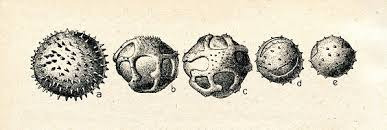
Paleosols often contain fossilized pollen which tells a lot about ancient ecosystems.
Who knew old dirt could be so informative!
#paleontology#fossils#geology#fun facts#science#prehistoric#palynology#paleosol#soil#cedar mountain formation
23 notes
·
View notes
Text
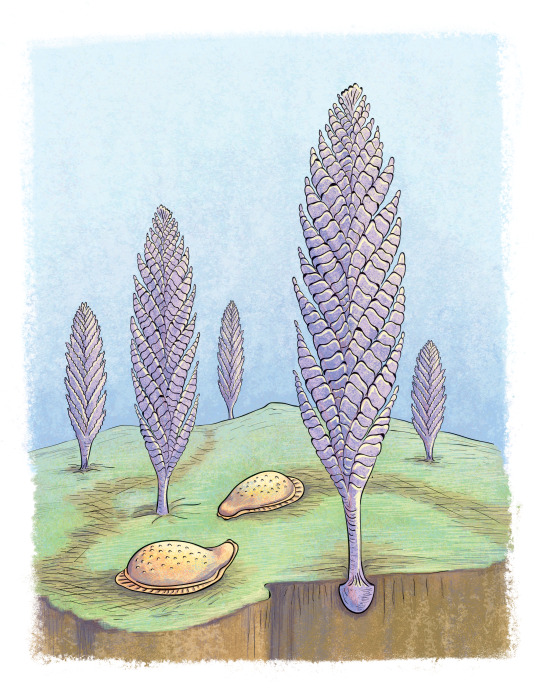
I made a small attempt at some paleo-reconstruction! Here we have a couple creatures from the White Sea assemblage--Kimberella and Charnia. I choose to believe the Ediacaran period was soft and pastel colored
51 notes
·
View notes
Text

Doug Wilson is the name of this piece of shit on 2 legs
The Southern Poverty Law Center connects Wilson's views to the neo-Confederate and Christian Reconstruction movements influenced by R. J. Rushdoony, concluding, "Wilson's theology is in most ways indistinguishable from basic tenets of [Christian] Reconstruction."[21] Though categorized by some as a “neo-Confederate”,[22] he rejects that term and calls himself a “paleo-confederate” instead.
What he is is a full-blown heretic and cannot be called ANY type of Christian AT ALL!!!
4 notes
·
View notes